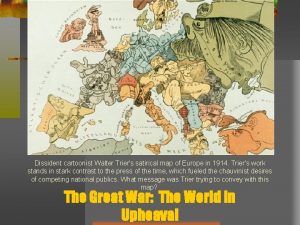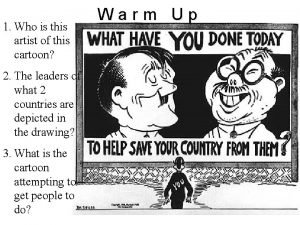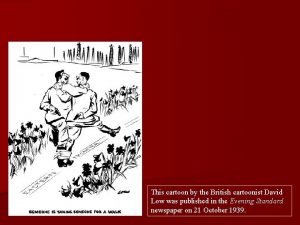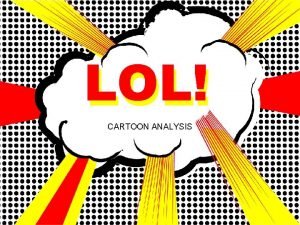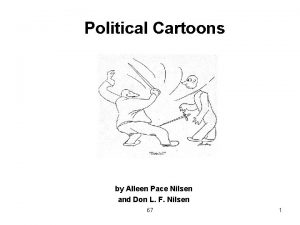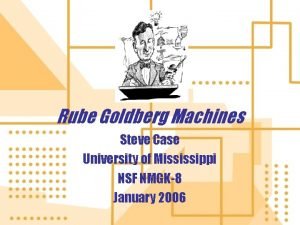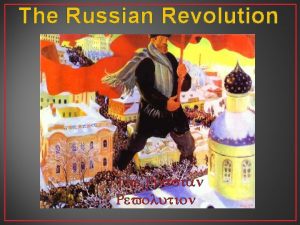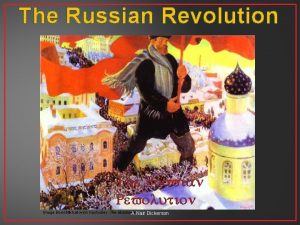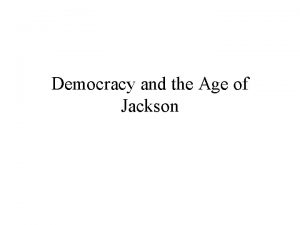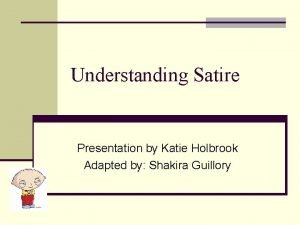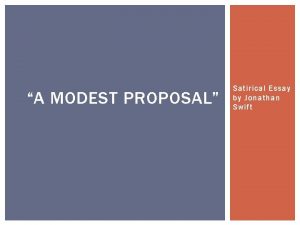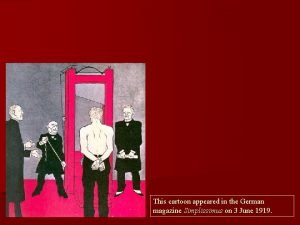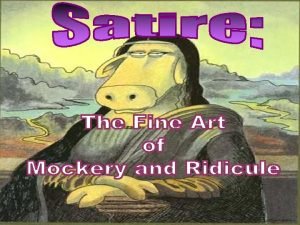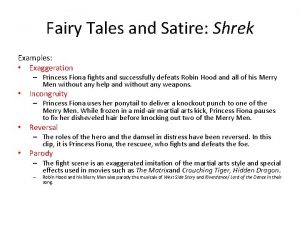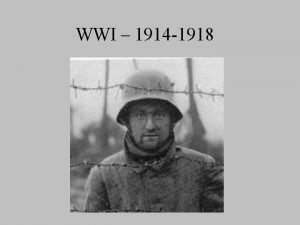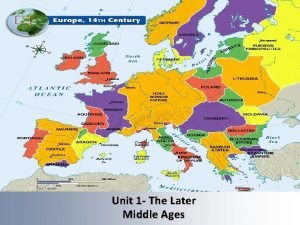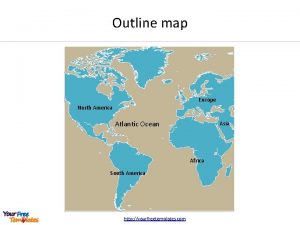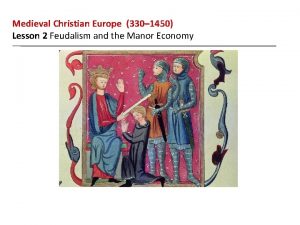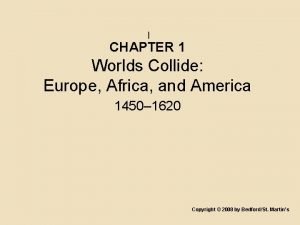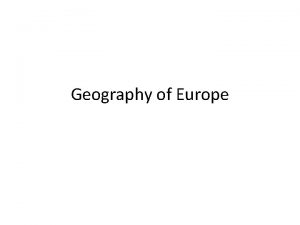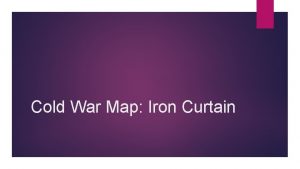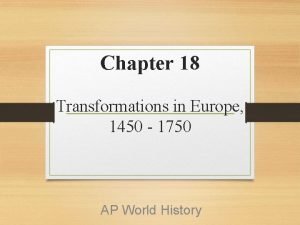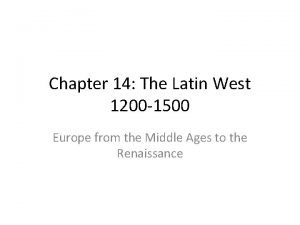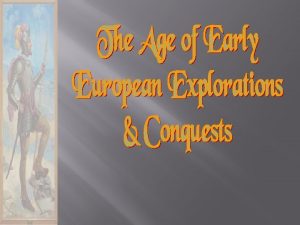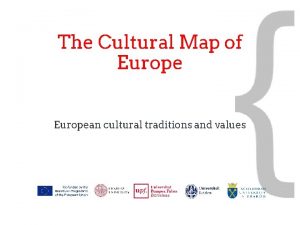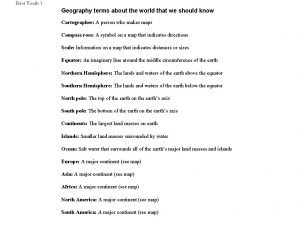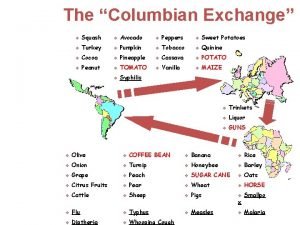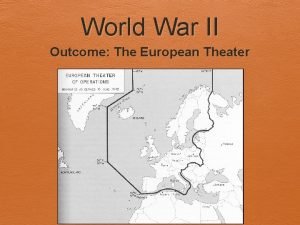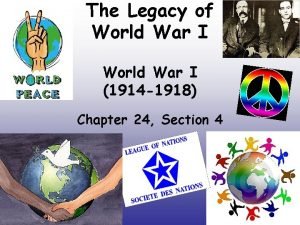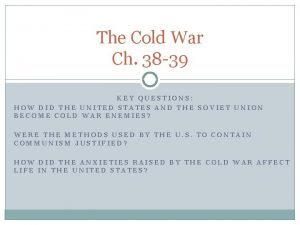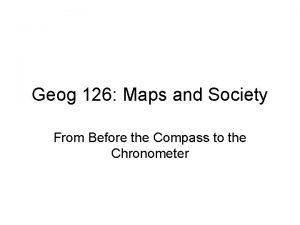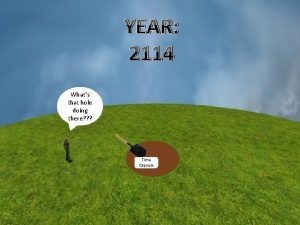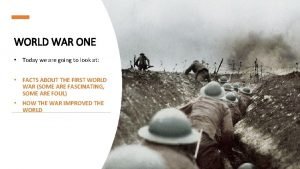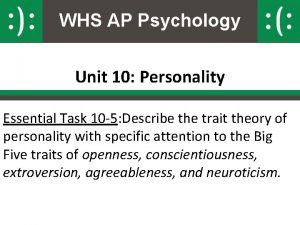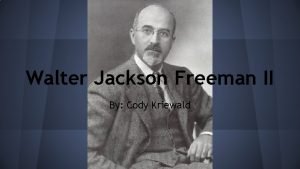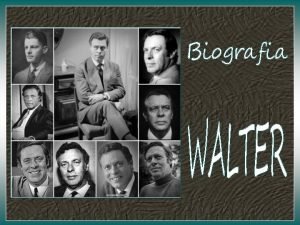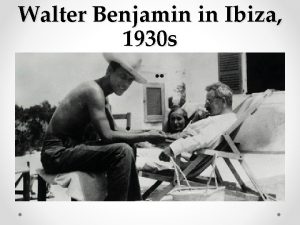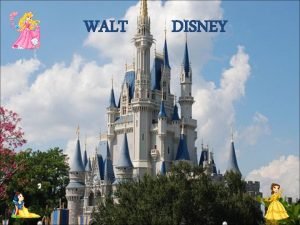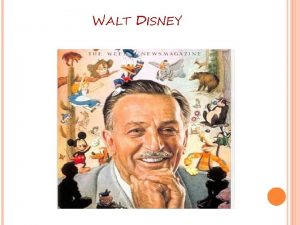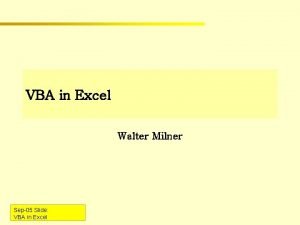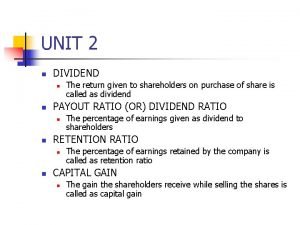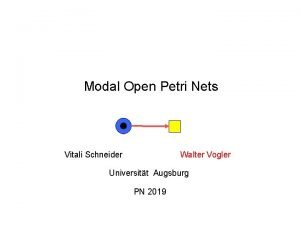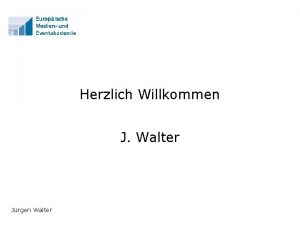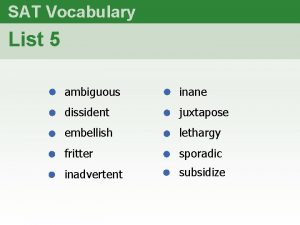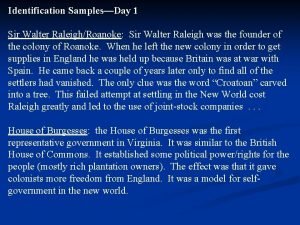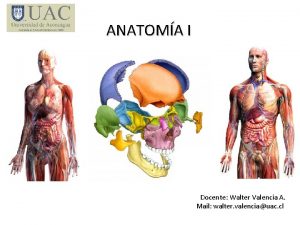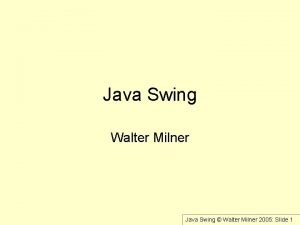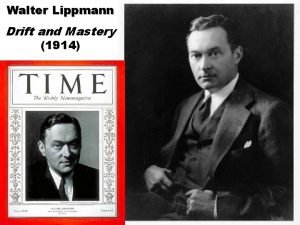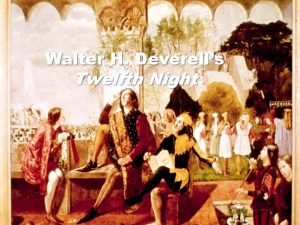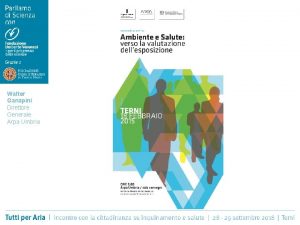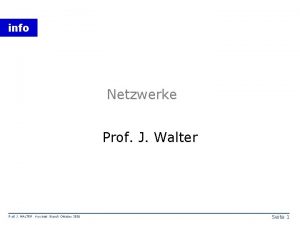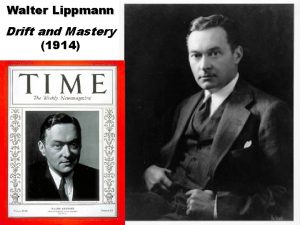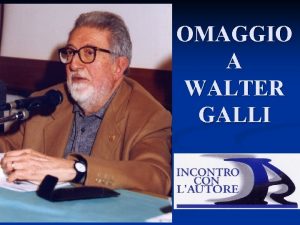Dissident cartoonist Walter Triers satirical map of Europe










































































- Slides: 74

Dissident cartoonist Walter Trier's satirical map of Europe in 1914. Trier's work stands in stark contrast to the press of the time, which fueled the chauvinist desires of competing national publics. What message was Trier trying to convey with this map? The Great War: The World in Upheaval

John Singer Sargent, Gassed, 1918 -1919, Imperial War Museum, London http: //jssgallery. org/Paintings/Gassed. htm

The Drift Towards War Nationalism French Revolution and Napoleonic Wars spread it through Europe Inherent in nationalism is the right to Self Determination: Peoples of the same ethnic origins, language, political ideals have the right to form sovereign states Often concept ignored by colonial power

Two Sides to Nationalism Unifying force United France, Britain, and Germany behind their gov’ts and gave them strength Divisive force Russia, Ottoman, and Austria-Hungarian Empires contained numerous ethnic and religious minorities Gov’ts could not rely on full support from minorities since minorities oppressed • Ex. Nationalist aspirations of Slavic peoples in Austria-Hungary

National Rivalries Territorial Disputes French loss of Alsace-Lorraine region to Germany from Franco. Prussian War 1871 Huge Rivalry b/n Great Britain and Germany Economic • England lost industrial output to Germany by 1914 Military • Expensive naval race to be used to control trade routes and protect merchant shipping • Keep an army “ready for war” • Both built super battleships: English naval ship German naval ship

Peace activist and Nobel Peace Prize winner: 1895 Frederic Passy “The entire able-bodied population are preparing to massacre one another; though no one, it is true, wants to attack, and everybody protests his love of peace and determination to maintain it, yet the whole world feels that it only requires some unforeseen incident, some unpreventable accident, for the spark to fall in a flash…and blow all Europe sky-high. ”

Colonial Disputes European nations continuously clash in corners of the globe Germany unified in 1871; came late to the colonial race German resentful that Britain and France had already “carved up the world” Balkan Wars (1912 -13) strained relations as they fought for possession of European territories of the Ottoman Empire

Public Opinion Citizens strongly patriotic Intense desire to “come in first” Content of cheap, mass-produced newspapers, pamphlets, and books fuel national Picasso’s Gunner Guillaume de Kostrowitzky, arrogance and 1914 Look for signs of “Napoleon’s glory of aggressive

The Tangled Alliance System Otto von Bismarck 1871 German “blood and iron” chancellor insisted Germany was a “satisfied” power and wanted to avoid war Feared war on 2 fronts so form alliances Kaiser Wilhelm II Came to throne at 29 Ambitious and impetuous Forced Bismarck to resign Built up military and navy to rival Britain

Understandings and Alliances http: //www. pbs. org/greatwar/maps_outbreak. html Triple Alliance Also known as the Central Powers Germany, Austria-Hungary Enter into it originally for fear of France/Russia Italy joins later b/c also fearful of France • Switches to Allied Powers in 1915 b/c promised “spoils of war” by Triple Entente Also known as the Allied powers France and Britain 1904 Russia added in 1907 Did not bind them to fight with each other, but that they would not against each other Signed a military pact in 1914 so in crisis they would not

The Balkans: “Powder Keg” of Europe Ottoman Empire on decline late 19 th c. “Sick Man of Europe” Many broke away on the peninsula Ex. Greece, Bulgaria, Serbia wanted to unite the Slavs on Peninsula Austria Hungary against it for fear it would stir rebellion of among its Slavic population 1908 Austria annexes Bosnia. Herzegovina with large Slavic pop.

The Guns of August June 28, 1914: Austrian Archduke Franz Ferdinand wife, Sophie were assassinated by Serbian nationalist: Gavrilo Princip July 28: Austria-Hungary declares war on Serbia Russia mobilizes troops to defend Serbia as ally on borders of Austria and Germany Aug. 1: Germany declares war on Russia and France, invades Belgium to reach France Aug. 4: To protect Belgium’s Gavrilo Princip, member of the Black Hand organiztion, who assassinated the Archduke and his wife in June 1914

The Guns of August This photograph from August 1914 documents the famous “guns of August” that sparked the Great War. Dogs carted this machine gun to the front in Belgium.

Reactions to the Outbreak of War German troops “To Paris” French troops “Send me the Kaiser’s moustache” German sociologist, Max Weber, “This war, with all its ghastliness, is nevertheless grand wonderful. It is worth experiencing. ” Sir Edward Grey, British foreign minister in late summer 1914, “The lamps are going out all over Europe. We shall not see them lit again in our lifetime. ” When war began, very few imagined that their side might This British recruiting poster reflects the enthusiasm that many British people felt at the beginning of the Great War, when they believed it would be a short and glorious adventure—an

The Great War in Europe and southwest Asia, 1914– 1918.

Powers Plan for War Military leaders devised inflexible military plans and timetables France’s Plan XVII focused on offensive maneuvers and attacks on German border Knew that they were heavily industrialized w/ rail so keep large # of troops at their border Germany’s Schlieffen Plan Try to avoid 2 front war Swift attack on France, then defensive attack on Russia Speed was vital so go through Belgium to get to France Of course, Belgium was neutral and not part of any “alliance”

Battle of the Marne Germans make it to outskirts of Paris by September 1914 Allies regroup and attack at the valley of the Marne River Every soldier taken to front 600 taxis from Paris sent After 4 days, Germans retreat Schlieffen Plan in ruins Germany will be forced to fight the 2 front war as Russian troops already invade from

Trench Warfare Opposing troops prepare their defenses Machine guns most potent weapon Great for defense, but useless for offense b/c weight, time to set up Soldiers dig trenches to escape streams of bullets All connected without gaps Dug communication trenches in back “No man’s land” littered with British trench at Battle of Somme, July 1916 Notice one soldier sleeps as the other stands guard

No Man’s Land Strewn with shell craters, cadavers, body parts Trenches Wet, cold, waist deep mud, lice, corpse-fed rats

Battle of Verdun Mutilated body on the western front. So tremendous was the number of the dead— over a half-million French and German soldiers perished in the battle of Verdun alone— that many were never recovered or identified. French rallying cry , “They shall not pass” -They didn’t but at a tremendous cost

Stalemate, 1914 -1917 By end of Aug. 1914, Germany had overrun Belgium and swept into France By Sept. 3, Germans were on the edge of Paris First Battle of the Marne 1914 One of the most important battles of WWI Allies push Germans back Proves that Germans quick victory is no longer possible Turns into long, bloody French soldiers waiting for assault stalemate and trench warfare behind ditch The deadlocked region running from North Sea to the

Western Front • A “terrain of death” • Nearly 500 miles from North Sea to Swiss border

Battles of WWI: The 1916 Bloodletting saw the bloodiest battles Verdun, 1916 Battle of Verdun Germans attack French forts Lose 281, 000 and cause 315, 000 French casualties Fewer than 160, 000 identifiable bodies recovered Germans advanced 4 miles Battle of the Somme River July British attack Germans in valley of the Somme River Britain 420, 000 casualties 60, 000 on 1 st day Germans lose 450, 000 French 200, 000 British gained 5 miles

Battle of Somme 1916

Eastern Front Battlefield along German and Russian border Russians and Serbs v. Germans and Austro. Hungarians

Russian Struggles By 1916, Russia’s war effort near collapse Russian army was continually short on food, guns, ammunitions, clothes, boots, and blankets. “ Cut off from Allied supply shipments b/c of German control of Baltic Sea Russian asset: Numbers Huge # of battlefield losses, but still could replace w/ their large population Held up the Germans

New Weapons of War German photo with British tank John Singer Sargent’s painting titled Machine guns Poison gas Wore masks for protection Introduced by Germans but used by both Caused blindness, severe blisters, death by choking Tank Armored combat vehicle that moved on chain tracks Introduced in Battle of Somme 1916 Slow, clumsy but eventually improved and

New Weapons: Poison Gas Air-raid warden in helmet and gas mask, holding a wooden gas attack rattle in his gloved hand. The deployment of poison gas represented a technological development of horrific dimension that was designed to break the stalemate of trench warfare by killing, on a massive scale, soldiers otherwise difficult to reach.

More weapons Airplane 1 st time used in combat Used for photos of enemy lines Both sides begin using them to drop bombs Guns attached and pilots fought each other in air Submarine 1914 introduced by Germans-U-Boats Germans waged “unrestricted warfare” on Allies U-boat sinking a troop transport ship

War Planes : Dogfights A dogfight between German and British planes during the Great War. Dogfights as a new type of combat resulted from the attempt of each contestant to prevent the enemy from conducting aerial reconnaissance

The War at Sea Britain Cuts German overseas telegraph cables Blockaded the coasts of Germany and Austria. Hungary Set out to capture or sink enemy ships at sea Germany Retaliates with blockade to British Germans attack every vessel they could British ocean liner, Lusitania • Death toll: 1, 198 people, 139 of them Americans • US protested, Germany ceases submarine campaign hoping to keep US neutral

Homefront and War Economy Wage total war: devote all resources to war Armies demand more weapons, ammunitions, food Gov’ts ration food, pay higher taxes Germany’s draft extended to 16 -60 Unemployment vanishes Thousands of Africans, Indians, Chinese recruited for heavy labor Women fill jobs vacated by men Women drawn to “male” jobs Most “crucial” job was shell-making although dangerous • TNT –poisoning b/c of exposure Middle-upper class women liberated from older attitudes 1917 Britain establishes auxiliary units for army, navy, air force and

Women at Work Women at work in an English munitions factory. The Great War drew huge numbers of men out of the workforce at a time of great industrial need. Women replaced them, for the first time assuming

Propaganda Gov’ts suppressed antiwar activity Censored news about war Used propaganda or one sided information to persuade and keep up morale Prosecute traitors who criticized the nation’s

Propaganda “The Heroes of Belgium 1914. ” French propaganda poster expresses outrage at the German invasion of Belgium.

Propaganda Posters, pamphlets, and “scientific “ studies depicting the enemy as subhuman who engaged in atrocities Ex. 1917 London Times published a story claiming Germans converted human corpses into fertilizer and food German propaganda poster showed image of bestial black Allied soldier raping German women

German War Economy German civilians paid high price British naval blockade severed overseas trade Contributes to ½ million German civilians starving Potato crop failure 1916 known as the “turnip winter” People forced to survive on 1, 000 calories/day Women, children, elderly hard hit

Colonies Help War Effort An Indian gun crew in the Somme area, 1916. During the Great War, colonial powers relied on millions of Asian and African men to fight or labor for their respective sides.

African Colonies Suffer in the War German colonies SW Africa and German Cameroon were conquered in 1915 by allies East Africa remained undefeated until end of war Europeans took foodstuffs, imposed heavy taxes and forced Africans to grow export crops and sell them at low prices Uprisings occur in colonies as few Europeans are there to lead 1, 000 Africans served in armies, 3 x that # serve as “porters” to carry army equipment Ex. France drafted Africans b/c of

Japan’s Entry into the War Japan claims it desires “to secure firm and enduring peace in East Asia” Demand Germany to handover German -leased territories in Asia w/out compensation They join Allies in Aug. 1914 and forces take German held islands of Pacific

The Twenty-One Demands Jan. 15, 2015 the Japanese presented China with 21 secret demands Some they agreed to Leaks out to British who stop it Reflects the Japanese determination to dominate East Asia and future relations with China

Ottoman Empire at War Aug. 2, 1914 sign secret alliance with Germany in hopes of gaining land against their enemy: Russia Gallipoli campaign was the most extensive military operation outside of Europe Winston Churchill (British Navy) suggested Allies strike Ottomans, the weak Central Power, to hurt Germans

Australian Aid Allies Australian recruiting poster. The British were keen to augment their forces by recruiting Australians and others to help defeat the Ottoman empire, which had allied itself with the Central

Gallipoli Campaign 1915 British expedition to seize the approach to the Dardenelles British, Canadian, Australian, and New Zealand soldiers land on beaches of Gallipoli Turkish forces pin them b/n hills and sea Engaged in trench warfare again, results in stalemate with 250, 000 casualties on each side Canada, Australia, N. Zealand

Long-term Effects of Campaign ANZAC Day Australian and New Zealand Army Corps April 25 th Most significant day of public homage Mustafa Kemal Commander of Turkish division makes a name for

Armenian Massacres 1915 By 1880 s, 2. 5 million Christian Armenians in Ottoman Empire had begun to demand their freedom 1890’s Turkish troops killed tens of thousands Turkish nationalism stressed Turkish culture and traditions and see them as an obstacle By WWI, Armenians pledge support for Ottomans enemies, Russia Fearing the Armenians, whom they expect to be pro-Russian, the Turks forced mass evacuations of 2 million of them from their homelands in eastern Anatolia During the forced march across the mountains, approx. 600, 000 died of starvation or were killed by Turkish soldiers “Those who fell by the wayside”, Ambassador Morgenthau's Story, written by Henry Morgenthau, Sr. and published in 1918.

Armenian Genocide Fundraising poster for the American Committee for Relief in the Near East – the United States contributed a significant amount of aid to help Armenians during the Armenian Genocide

Armenian Massacre Debate Turkish gov’t rejects the label of it being a genocide but from a communal warfare perpetrated by Christians and Muslims, disease, and famine

The United States in WWI Grew rich during the war Neutral but did roaring business supplying France and Britain Businesses engaged in war production made huge profits Civilians invested in war bonds and growing food in backyard, “victory gardens” Employment opportunities reason for African American

America Joins the Fight Jan. 1917 Germany resumes their unrestrictive submarine warfare in Atlantic to block Britain Sank 3 American ships Zimmerman note intercepted February 1917 Stated that Germany would help Mexico “reconquer” the lost territory to the US if they ally with them President Wilson asks Congress to declare war on

The Influenza Epidemic In the spring of 1918, a powerful new enemy emerged, threatening nations on each side of World War I. This “enemy” was a deadly strain of influenza. The Spanish flu, as it was popularly known, hit England India in May. By the fall, it had spread through Europe, Russia, Asia, and to the United States. The influenza epidemic killed soldiers and civilians alike. In India, at least 12 million people died of influenza. In Berlin, on a single day in October, 1, 500 people died. In the end, this global epidemic was more destructive

Allies Win the War 1917 Russia withdraws from the war because of civil unrest and revolution Allows Germany to launch massive attack on Western Front Fresh American troops push back Germans and Central Powers begins to crumble Bulgarians and Ottoman Turks surrender Revolts in Austria Hungary Germany signs an armistice (ceasefire) in November 1918 and the war came to an end Kaiser Wilhelm II stepped down

Legacy of War Use of new technologies War on global scale Price of human life Death of soldiers amd civilians Lost generation of men Economic impact Drained economic

Double Revolution in Russian in 1916 suffering numerous defeats Run out of ammunition, ordered to use guns of fallen, railroads break down, crops rot in fields, widespread hunger, fuel scarce February Revolution of 1917 Food runs out in Petrograd, (St. Petersburg) Women stage massive demonstrations, soldiers mutinied Striking workers join soviets (councils) to take over factories and segments of military Czar Nicholas II and family abdicate throne • Set up a provisional gov’t Petrograd, July 4, 1917. Street demonstration on Nevsky Prospekt just after troops of the Provisional Government have opened fire with machine guns.

What’s a Soviet? Revolutionary councils that consisted of workers, peasants, and soldiers Had great influence in the cities Become more powerful than the provisional gov’t

Provisional Gov’t’s Struggle for Power Political struggles b/n Soviets and the Provisional Gov’t makes changes Peoples support at first Disband police Repeal limits on speech, press Abolish laws that discriminate against ethnic groups Workers demonstration in March 1917. Left banner reads “Feed the children of the defenders of the motherland"; the right banner, "Increase payments to the soldiers' families - defenders of freedom and world peace“. Still didn’t satisfy popular demands for an end to the war and land reform The provisional gov’t pledged to keep commitment to allies Soviets, in contrast, call for immediate peace and gain

Lenin (1870 -1924) Son of gov’t official, prosperous family Brother executed for plotting to kill the czar Years in exile in Siberia and Switzerland Devotes time studying Marxist thought & writing political pamphlets His goal was to create a party that would lead revolution April 1917 snuck in a sealed railway car by the Germans Bolshevik slogans: “All Power to the Soviets!” and “Peace, Land, Gained support by promising immediate peace, all power

The October Revolution On Nov. 6, 1917 (Oct. 24 th in Russian calendar-Julian) Bolsheviks rose up to take over city of Petrograd (St. Petersburg) Bolshevik, by Boris Kustodiev, located in Moscow at The Tretyakov Gallery Nationalized all private lands and order peasants to hand over crops w/out compensation Took over factories and drafted the workers into required labor brigades Created a secret police to arrest and execute opponents US journalist, John Reed 18871920, who witnessed the Bolshevik seizure of power referred to them as

Treaty of Brest-Litovsk Bolshevik leaders sign it with Germany on March 3, 1918 Gave Germany possession or control of 1/3 of Russia’s territory and ¼ of population Lost Poland, Finland, and Baltic States (Latvia,

The End of the War in Western Europe, 1917 -1918 US President Woodrow Wilson wanted to stay out of the conflict Late 1916 Germany practicing unrestrictive submarine warfare sinking ships supplying food supplies to Britain This would bring in US April 2, 1917, Wilson asked Congress to declare war on Germany “The world must be safe for democracy. ” Woodrow Wilson’s war message.

The Collapsing Fronts Last 2 years of war have little support and much rebellion Spring 1918 Germans try to throw all might to western front It failed Bulgaria surrendered 1918 Ottomans concluded an armistice on Oct. 30 Austria-Hungary surrenders Nov. 4 Germany accepts armistice on Nov. 11, 1918

Collapsing Fronts German prisoners taken in France in the autumn of 1918. Millions of soldiers had been captured and imprisoned by war's end, and many more had died or been wounded. Over fifteen million had been killed and twenty million wounded by the time of the armistice on 11 November 1918.

Paris Peace Conference 1919 Leaves a bitter legacy 32 nations represented w/ different and conflicting aims Big three: Georges Clemenceau of France, Lloyd George of Britain, and Woodrow Wilson of US, and Vittorio Orlando of Italy Central Powers not permitted to attend Signing of the Treaty of Versailles in 1919 in the Hall of Mirrors

Signing of the Treaty of Versailles Political leaders sign the Treaty of Versailles, which, among other provisions, controversially compelled the Germans to accept sole responsibility for causing the war.

Wilson’s Fourteen Points Wilson’s proposal that prompted Central Powers to end war They accepted this proposal as basis for armistice and thought they would be used at conference First Five Points Included an end to secret treaties, freedom of the seas, free trade, and reduced national armies and navies Adjustment of colonial claims with fairness toward colonial peoples Sixth –Thirteenth Points Suggestions for changing borders and creating new nations Guiding idea behind it was SELFDETERMINATION • Allow people to decide what gov’t they wished to live Fourteenth Point Proposal of a “general association of nations” that would protect “great and small states alike”

The Peace Treaties Hardest terms originate with the French who wants permanent weakening of Germany and Britain Treaty of Versailles 1919

Treaty of Versailles, June 28, 1919 “War Guilt Clause” –Article 231 required Germany to accept sole responsibility for the war and pay reparations to Allies for next 30 years Demand a reduction of military of former Central Powers Ex. German army limited to 100, 000 Denied German navy and air force Prohibit any political union of Germany and Austria

Other treaties Treaty of St. Germain and Trianon 1920 Divide Austria and Hungary Suffer severe territorial losses Ex. Hungary to 1/3 of size and pop. goes from 28 to 8 mil. Treaty of Sevres 1920 Dissolved the Ottoman Empire Not acceptable to Turkish nationalist: Mustafa Kemal Head of Turkish nationalist movement Drives out Greek, French, British, Italian forces Abolishes sultanate and replaces it with Turkish nationalists Republic of Turkey is recognized in 1923 Mustafa Kemal or Ataturk becomes 1 st President of Turkey • Westernization and gov’t policy of secularization that separated existing Muslim religion and state

Territorial Changes in Europe after the Great War

League of Nations Created as a world organization to safeguard peace and international cooperation Flaw is that it had no power to enforce decisions It relied on “collective security” Aggression from one state is aggression against all Never happens because major powers didn’t always belong

New Nations Self-determination key to int’l peace In Europe, it becomes reality but not Europe’s new countries Poland Czechoslovakia Yugoslavia – “Land of the South Slavs”

Territorial Changes in SW Asia after the Great War

The Mandate System !! Self-determination applied to Europe, but not elsewhere How they dealt with Germany’s former colonies in Africa, Arab territories of Ottoman Empire Mandate system – Examples French control in Lebanon and Syria British control in Palestine and Iraq Allies view it as a compromise b/n imperialism and self-determination To the people, more imperialism

“Peace Built on Quicksand” No lasting peace US rejects it b/c we want to stay out of European affairs Isolationism We sign separate treaty with Germany and its allies several years later War Guilt Clause left legacy of bitterness and hatred for Germans Africans and Asians angry b/c they did not get their independence Mandate system just more colonialism Japan and Italy gained less than what they thought they would gain by joining Allies
 Walter trier satirical map of europe
Walter trier satirical map of europe Who is the cartoonist
Who is the cartoonist Who is this artist
Who is this artist Famous british cartoonists
Famous british cartoonists Analysis cartoon
Analysis cartoon Jack higgins cartoonist
Jack higgins cartoonist Cartoonist nsf
Cartoonist nsf In the view of this cartoonist russia under
In the view of this cartoonist russia under In the view of this cartoonist russia under
In the view of this cartoonist russia under Senior citizen age
Senior citizen age Techniques of satire
Techniques of satire The elephant by slawomir mrozek theme
The elephant by slawomir mrozek theme A satirical elegy analysis
A satirical elegy analysis Satirical argument examples
Satirical argument examples Satirical defintion
Satirical defintion Modest proposal by jonathan swift
Modest proposal by jonathan swift Who are the members of the propaganda movement
Who are the members of the propaganda movement Cartoon in german
Cartoon in german Satire techniques
Satire techniques Parody examples in shrek
Parody examples in shrek Houston to honduras
Houston to honduras Wwi n
Wwi n Map of europe 1914
Map of europe 1914 Western uplands europe
Western uplands europe Map of europe in middle ages
Map of europe in middle ages Europe 1990 map
Europe 1990 map Atlantic ocean outline map
Atlantic ocean outline map Feudal europe map
Feudal europe map Abcdarab
Abcdarab Map of europe numbered
Map of europe numbered Danube river map
Danube river map Cold war map activity
Cold war map activity Europe map 1750
Europe map 1750 Renaissance europe 1500 map
Renaissance europe 1500 map World map before 1492
World map before 1492 Europe cultural map
Europe cultural map World geography terms
World geography terms Vavocado
Vavocado Europe the alps
Europe the alps Map of ww2 europe
Map of ww2 europe Did wilson want to join the league of nations
Did wilson want to join the league of nations Map of europe 1950
Map of europe 1950 Europe after ww2 map
Europe after ww2 map Canespon
Canespon Prime meridian map europe
Prime meridian map europe Map of europe 1914
Map of europe 1914 Walter dean myers
Walter dean myers Walter yeo
Walter yeo Walter mischel ap psychology
Walter mischel ap psychology Walter freeman
Walter freeman Walter hartjes
Walter hartjes Walter gropius 1883-1969
Walter gropius 1883-1969 Walter gerhard
Walter gerhard Walter de caro
Walter de caro Walter benjamin escuela de frankfurt
Walter benjamin escuela de frankfurt Walter benjamin ibiza
Walter benjamin ibiza Walter walt disney
Walter walt disney Walt disneys childhood
Walt disneys childhood Findfile vba
Findfile vba Payout ratio formula
Payout ratio formula Bad boy walter dean myers summary
Bad boy walter dean myers summary Mr irwin lasher
Mr irwin lasher Walter cunningham personality
Walter cunningham personality Walter the worm book
Walter the worm book Walter bleakley
Walter bleakley Life quote from walter mitty
Life quote from walter mitty Rotter and mischel
Rotter and mischel Walter jaeger smoke detector
Walter jaeger smoke detector Rebtdoctor
Rebtdoctor Walter haase ntua
Walter haase ntua Monster vocabulary
Monster vocabulary Monster walter dean myers vocabulary
Monster walter dean myers vocabulary Modelo de walter dick y lou carey
Modelo de walter dick y lou carey Vitali schneider
Vitali schneider Buzz schneider miracle
Buzz schneider miracle
